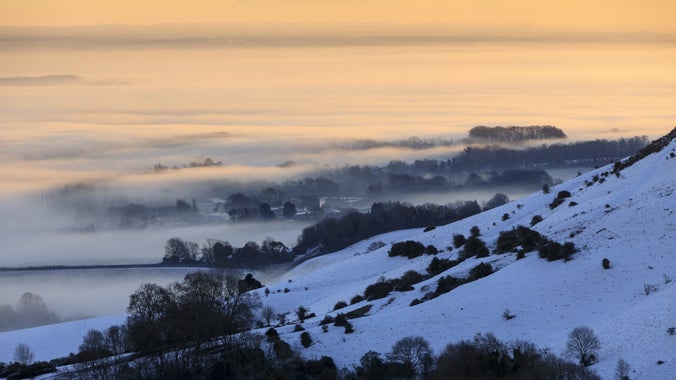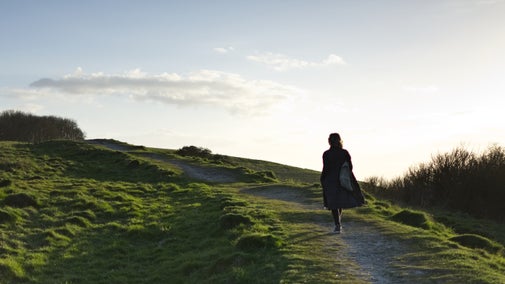
Become a member
Join today and help protect nature, beauty and history – for everyone, for ever. Enjoy access to more than 500 places with National Trust membership.
A hidden hamlet nestled in the downs
Saddlescombe Road, near Brighton, West Sussex, BN45 7DE

| Asset | Opening time |
|---|---|
| Newtimber Hill | Dawn - Dusk |
Saddlescombe Farm has rough, uneven tracks but is suitable for most wheelchairs, buggies, and pushchairs. Newtimber Hill has steep paths and stiles. One accessible toilet for café. Dogs on leads welcome.
Saddlescombe Road, near Brighton, West Sussex, BN45 7DE
Find out about bringing your dog to the South Downs. Explore the beautiful landscape together, from cliff-tops and beaches to ancient downland.

Near Devil's Dyke in West Sussex, the hamlet is only five miles from the seaside city of Brighton. It is a hidden gem on the South Downs Way and is a great place to visit on the way to Devil's Dyke.
This is Sussex countryside at its finest with ancient woodland, chalk grassland and long reaching views of the sea and across the Weald. It is also a real hot spot for rare flora and fauna like the silver spotted skipper butterfly, burnt orchid and juniper. A 1,000 year old lime tree and bluebells galore hide in the woodland.
It has seen hundreds of years of occupation since it was first recorded in the Domesday Book and once home to the Knights Templar. The oldest part of the present day farmhouse dates from around 1630. Tucked amongst the outbuildings you will find an incredibly well preserved example of a donkey wheel. These were used to raise water from a well 50m below the farm.
Today Saddlescombe is a working farm hamlet so some areas are closed to the public. You are still welcome to visit the donkey wheel and spacious information barn at any time of the year. Both are signposted from the South Downs national trail which runs through the farm.
With the South Downs Way footpath, ancient woodland and a working farm, there’s plenty to see and do at Saddlescombe Farm and Newtimber Hill. Visit the donkey wheel or information barn for a flavour of life here.

The surrounding landscape of Saddlescombe Farm is rich in variety and diversity. From chalk grassland and rare chalk heath to ancient woodland and dew ponds, it supports a varied mix of wildlife.

Wolstonbury Hill stands proud as a gateway to Brighton. A hill with layers of human memories and an important chalk grassland area supporting a wide variety of wild orchids.

Explore the South Downs for breathtaking landscapes, historic sites, and family-friendly activities. You can visit iconic spots like Devil's Dyke, Birling Gap, and Saddlescombe Farm for restorative time in nature

Fresh air, spectacular views and an ancient landscape will accompany you along this scenic downland walk near Devil's Dyke.

A 3-mile walk on the South Downs, where you can see wild flowers and butterflies, including the Adonis and chalkhill blues, dark green fritillary and silver-spotted skipper, in summer.

Sorry, there are no upcoming events at this place
Newtimber Hill is Sussex countryside at its finest with ancient woodland, chalk grassland and long reaching views of the sea and across the Weald. In early autumn, the hill is covered in a purple blanket of devil's bit scabious. It is also a real hot spot for rare flora and fauna like the silver spotted skipper butterfly, burnt orchid and juniper. A 1,000 year old lime tree and bluebells galore hide in the woodland.
Saddlescombe is a hidden gem on the South Downs Way.
Near Devil's Dyke in West Sussex, the hamlet is only five miles from the seaside city of Brighton.
It has seen hundreds of years of occupation since it was first recorded in the Domesday Book and once home to the Kinghts Templar. The oldest part of the present day farmhouse dates from around 1630. Tucked amongst the outbuildings you will find an incrediblly well preserved example of a donkey wheel. These were used to raise water from a well 50m below the farm.
Today Saddlescombe is a working farm hamlet so some areas are closed to the public. You are still welcome to visit the donkey wheel and spacious information barn at any time of the year. Both are signposted from the South Downs national trail which runs through the farm.
Evidence of human settlement, dating back to the Mesolithic and Bronze Ages, has been found here. Its many owners include the Knights Templar and generations of farming families.

The South Downs have been a place to live, work and play for thousands of years. Together we can make sure they will be enjoyed for thousands more. Learn how the projects of the Changing Chalk partnership, led by the National Trust, are restoring lost habitats, bringing histories to life, and providing new outdoor experiences across the eastern South Downs, and discover how you can get involved.

Join today and help protect nature, beauty and history – for everyone, for ever. Enjoy access to more than 500 places with National Trust membership.
By sharing your email address you’re agreeing to receive marketing emails from the National Trust and confirm you’re 18 years old or over. Please see our for more information on how we look after your personal data.